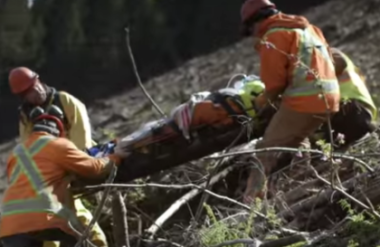Having an emergency response plan (ERP) is critical, but just as important is making sure the plan works.

Image from WorkSafeBC video: Every Minute Counts: Emergency Response Planning in Forestry
That’s the message behind Every Minute Counts: Emergency Response Planning in Forestry, a new video by WorkSafeBC.
“A plan may need to be revisited and adjusted as often as every day, depending on how often factors change for your operation,” reads the video discussion guide.
“These factors may include the location, work specs, weather, crew, and the equipment being used.”
Al Johnson, WorkSafeBC’s vice-president of Prevention Services, launched the new video at the 10th Annual Vancouver Island Safety Conference in October to more than 400 forest industry delegates.
“It is an excellent video because it is realistic, reflecting challenging forestry conditions and the barriers crews need to deal with to safely evacuate an injured worker,” says Rob Moonen, Director of SAFE Companies, BC Forest Safety Council.
“To date we’ve heard very positive comments about the video from forestry workers. One of the most important messages in the video is not just about having a good ERP, but making sure you practice it to really be prepared.”
WorkSafeBC created the video in consultation with the BC SAFE Silviculture Program, the BC Forest Safety Council, and others from the logging industry. It shows the many challenges of an emergency evacuation, which is even more challenging because it’s the safety supervisor, who knows most about the plan but isn’t able to give direction because of his injury.
“Emergency response planning is not a slam dunk,” says Lisa Houle, WorkSafeBC industry specialist for forestry, who led the video team. “Testing your plan is really important because it tells you if the plan will work. Every time you do a drill, you’ll find things you can improve on.”
This video is part of an ongoing effort to address challenges faced by this industry, which I wrote about in my post Planning for emergencies in remote forest locations.
More information is available in 12 tips for an effective emergency response plan (ERP), another new resource from WorkSafeBC, and in the video discussion guide.


